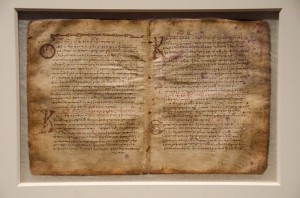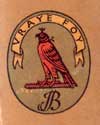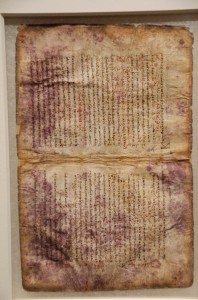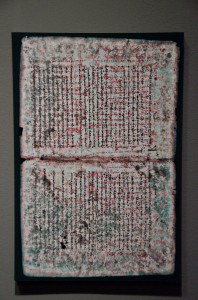Thu 29 Dec 2011
Archimedes Palimpsest at Walters Art Museum
Posted by boz under Art , General , History , Science , TechnologyComments Off on Archimedes Palimpsest at Walters Art Museum

The Walters Museum in Baltimore has some leaves from the Archimedes Palimpsest on exhibit (through Jan 1, 2012). I took the kids to visit the exhibit today.
Very nice venue, and the exhibit was well laid out. While the museum is kid-friendly (they hand out satchels with crafts/activities related to the exhibit for the kids to work on), looking at “old books” didn’t hold the attention of a 5-year old for more than 30 minutes (which I thought was a lot). Granted, about 10 of those were a video presentation. Little Olivia fell asleep in her stroller…
The Archimedes Palimpsest is a Medieval parchment manuscript. The currently visible part of the manuscript is a Byzantine Prayer book, written around 1229 AD. What makes it interesting is that the parchment used for the prayer book is actually comprised of previous manuscripts from about the 10th century. The scribe in the 13th century used a knife and scraped off the older text so as to reuse the parchment for the prayer book (“Palimpsest” is from the Greek, meaning “scraped again”). You can do this with parchment (sheep skin) as it is quite durable. The previous manuscripts comprise some 7 treatises by Archimedes – and for 2 of these there was no known existing text. Now there is!
The underlying Archimedes text is revealed via a technique called “multispectral imaging”. Basically, many digital images are taken of the parchment, each at a different wavelength of light – some in the ultraviolet, invisible to the eye. These images are further processed to get the best resolution of the underlying text. Not every page of the manuscript was in great condition, so sometimes images were enhanced by using high-intensity X-rays (which would basically scatter off the iron in the older ink). All-in-all this was a very time-consuming process, not the least of which was actually dismantling the palimpsest so the imaging could be done.
Non-flash photography is allowed, so:
Why is the older Archimedes text perpendicular to the overlaid text? Because the previous manuscript was folded/creased, so the scribe would cut it in half for re-use, then re-fold it again after turning it.


